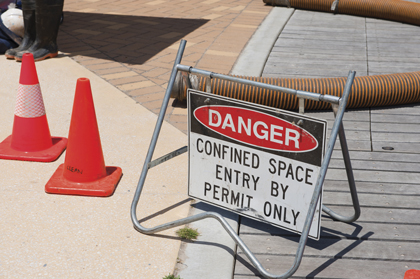According to OSHA, a confined space is a space whose configuration and/or contents may present special dangers not found in normal work areas. Confined spaces may be poorly ventilated and, as a result, contain insufficient oxygen or hazardous levels of toxic gases. Working in a tight space can prevent a worker from keeping a safe distance from mechanical and electrical hazards in the space. Fumes from a flammable liquid that is used in a poorly ventilated area can reach explosive levels. Such hazards endanger both the workers in the confined space and others who become exposed to the hazards when they attempt to rescue injured workers. In a number of cases, rescue workers have themselves died or been injured because they did not have the training and equipment necessary to conduct the rescue safely.
EVALUATE ALL CONFINED SPACES
Because confined spaces are potentially dangerous, employers must evaluate all confined spaces in which their employees work to determine whether hazards exist or whether the work to be done in the space can create hazards. If a confined space contains an actual or potential hazard that can cause death, injury or acute illness, incapacitation, entrapment, or otherwise interfere with a worker’s ability to leave the space in an emergency, it is a permit-required confined space, or permit space.

Employers must take certain precautions whenever workers enter a permit space. These include specifying the precautions to be taken to protect the workers in the space, training the workers who are covered by the standard to give them the knowledge to protect themselves and others, and planning how to rescue injured workers promptly and safely.
OSHA STANDARD
OSHA offers a guide intended to help small businesses comply with the Confined Spaces standard. It addresses the most common compliance issues that employers will face and provides sufficient detail to serve as a useful compliance guide. It does not, however, describe all provisions of the standard or alter the compliance responsibilities set forth in the standard, which is published at 29 CFR 1926 1200-1213. Contractors must refer to the standard itself, which is available on OSHA’s website (www.osha.gov) and in the Code of Federal Regulations, to determine all of the steps that must be taken to comply with the standard.
MONITORING SOLUTION
Introducing a portable gas detector you can count on for monitoring confined spaces for toxic levels of H2S, CO, O2, and combustible gases (LEL)—the Multi Gas Clip Simple from Gas Clip Technologies. Designed to never need charging for 2 full years, the detector is durable, ergonomic, and has a simple one-button operation. The Gas Clip works in oxygen enriched and oxygen deficient environments. The LEL sensor is immune to H2S and silicone poison. Full datalogging takes place at 1 second intervals. The display is large and easy to read. It’s the detector that every worker tasked with working in a confined space needs to continuously monitor for any potential hazard.
Confined spaces that may be found on construction sites include, but are not limited to:
- Manholes (such as sewer, storm drain, electrical, communication, or other utility)
- Sewers
- Water mains
- Lift stations
- Pits (such as elevator, escalator pump, valve, or other equipment)
- Concrete pier columns
- Heating, ventilation, and air-conditioning (HVAC) ducts
- Precast concrete and other pre-formed manhole units ■
For More Information:
For more information about the 4-gas detector, Multi Gas Clip Simple, from Gas Clip Technologies, visit www.gascliptech.com.
_________________________________________________________________________
Modern Contractor Solutions, July 2017
Did you enjoy this article?
Subscribe to the FREE Digital Edition of Modern Contractor Solutions magazine.



